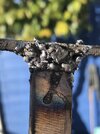Hello
so, I brought a cheap arc welder, due to having a few bits around the house that has broken and needed repairs. As there was a lot of small repairs the quotes I was getting was at least 5 times the cost of a welder.
So, my first attpemt at welding, I managed to melt part of an iron bed frame, but the “fix” I did to it had made it stronger, and the slat near the support leg was completely cracked/split. I have managed to fix that, it’s ugly, and it’s not clean, but I have kind of bridged the crack.
so, my mums bed is now fixed, and stronger than before.
so, now I am attempting to fix my bed, but again, it’s ugly and wanted some advise on how to make the fix better.
here are some pictures of my bed support leg that completely snapped and now repaired. Any tips would be great, thank you.



so, I brought a cheap arc welder, due to having a few bits around the house that has broken and needed repairs. As there was a lot of small repairs the quotes I was getting was at least 5 times the cost of a welder.
So, my first attpemt at welding, I managed to melt part of an iron bed frame, but the “fix” I did to it had made it stronger, and the slat near the support leg was completely cracked/split. I have managed to fix that, it’s ugly, and it’s not clean, but I have kind of bridged the crack.
so, my mums bed is now fixed, and stronger than before.
so, now I am attempting to fix my bed, but again, it’s ugly and wanted some advise on how to make the fix better.
here are some pictures of my bed support leg that completely snapped and now repaired. Any tips would be great, thank you.


